Good Posture: How Functional Training Can Help You Stand Taller

Pain relief, confidence, and better athletic performance can all come from correcting bad posture. Learn how to hold your body more efficiently with functional training.
Table of Contents
- What are the Mental and Emotional Effects of Bad Posture?
- What Are the Physical Effects of Bad Posture?
- Good Sitting Posture
- Good Standing Posture
- Good Athletic Posture
- Bad Standing Posture
- Does Bad Posture Really Matter?
- What Causes Bad Posture?
- How to Fix Bad Posture with Functional Training
- 4 Keys for Good Posture
What Are the Mental and Emotional Effects of Bad Posture?
Some of the clearest effects of poor posture are related to mental health. For many people, poor posture is the cause of worry, anxiety, and low self-confidence. And many people lose confidence because of their poor posture. As humans, we interpret body positions as mental and emotional states. This is body language 101.
For example, what ideas do you have about someone in a hunched posture?
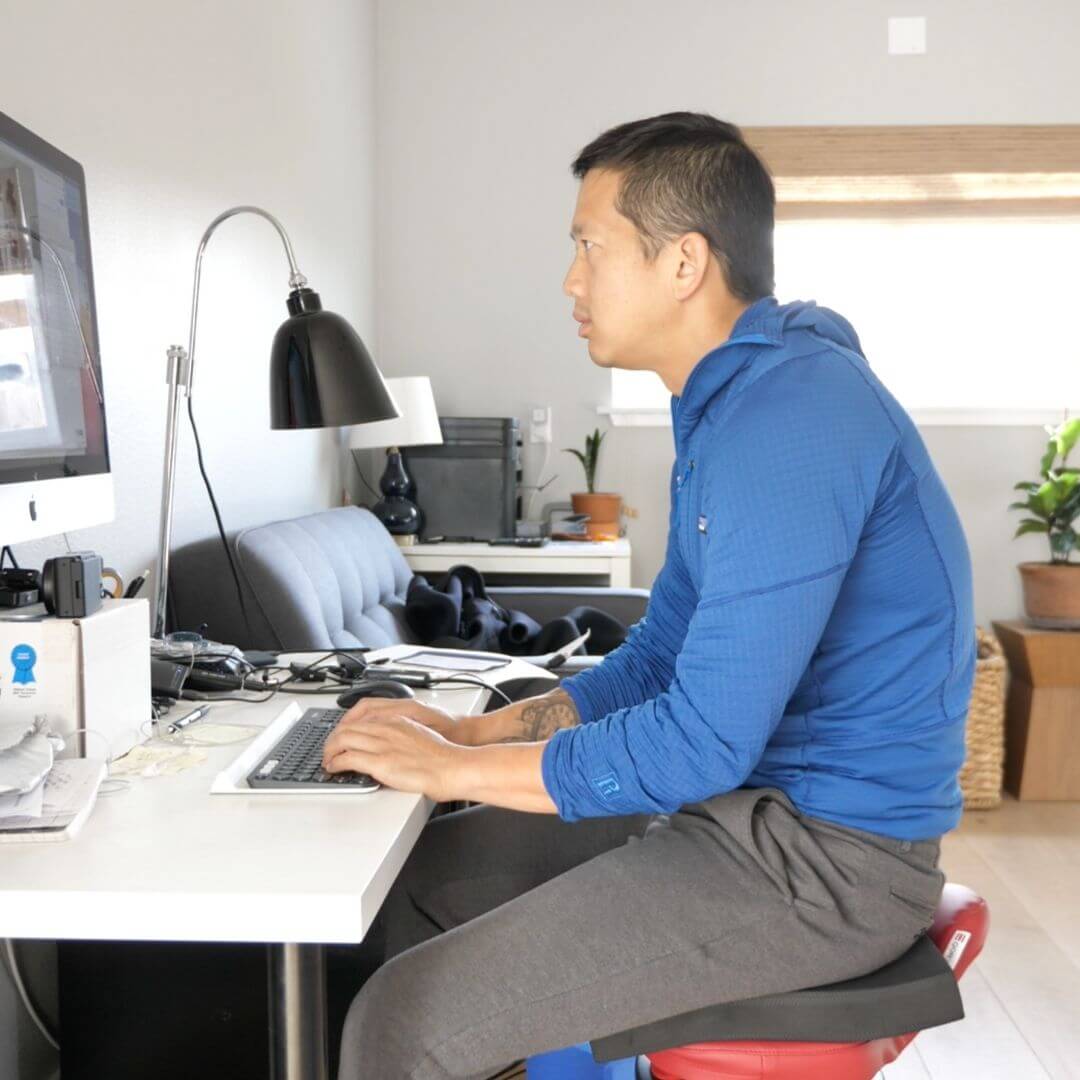
What does Matt’s posture in this picture say about his mood?
What ideas do you have about someone standing with good posture?

How you stand can make a big difference in how you are perceived. Photo by Rana Sawalha on Unsplash.
Body language communicates tone, helping us navigate situations and relationships every day. If your boss has this posture, it’s probably not a good time to talk with him about a raise.

Don’t mess with this. Photo by Crypto Crow from Pexels.
If you feel stuck in bad posture, you can get frustrated that you’re constantly giving the wrong impression. Bad posture often says some combination of “I’m not confident,” “I’m not strong,” and “I’m not healthy.” And that’s not helpful if you’re angling for new friendships, romantic relationships, job promotions, sales deals, or pay raises.
Watch this video: How to Fix Hunchback Posture in 3 Minutes
What Are the Physical Effects of Bad Posture?
Physically, bad posture can lead to restrained breathing, a pinched voice, headaches, neck pain, shoulder pain, wrist and hand pain, back pain, hip pain, and even pain in your knees, ankles, and feet.
Just think about what happens if you stick your head forward for a long period of time (like when you sit at the computer). Your neck muscles get tired. Your shoulders get sore. If you pay close attention, you may notice your voice get more nasal.
If you slump onto a couch and don’t move for six hours, your back and hips get sore, stiff, and achy.
If you stand for long periods with your shoulders hunched, head jutting out, and your tailbone tucked, your body will definitely feel off.
If you place your body in these same positions every day, you’ll find it harder and harder to undo the negative effects of bad posture.
Over years, bad posture becomes ingrained and the effects on your mood and physical health start to seem like an unchanging and unchangeable part of your life.
In fact, most people are unsure of what good posture even looks like! And many physicians and health professionals are so blinded by bad posture everywhere (including in the mirror), that they have turned nihilistic and said, “There’s just no such thing as good posture!”
Watch this video: How To Improve Posture—Top Myths, Questions, And Mistakes
Good Sitting Posture
Let’s take a moment to examine good posture.
Good posture is the positioning of your body and all its parts to minimize energy expenditure and maximize movement options for whatever challenges arise in the next moment.
Remember that gravity constantly pulls us down. Therefore how we position our bones in space always affects how much work our muscles need to do.
For example, if you’re sitting at the computer, there’s an optimal position that will require the least amount of muscular effort to maintain for long periods of time.
But, if you position your head, shoulders, and upper spine in front of your hips, you’ll force specific muscles along the spine, shoulders, and neck to do extra work to stop you from curling and falling forward into the keyboard.
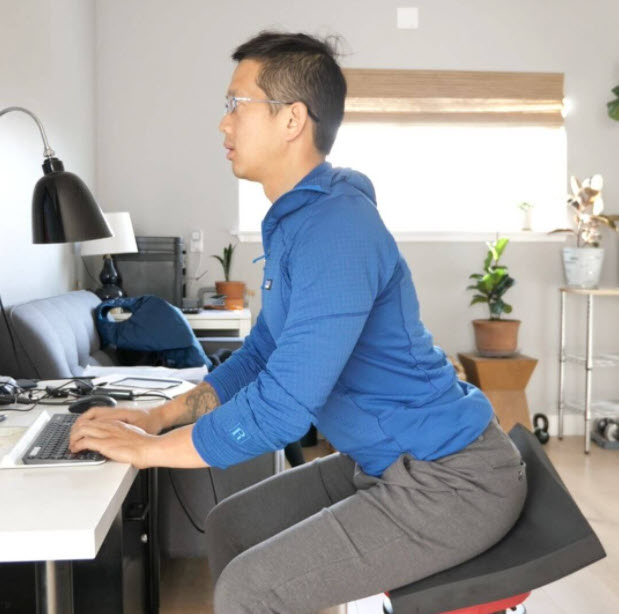
Putting your upper body forward of your hips forces more muscle activity to keep you from falling over.
Or, if you position your hands and arms high up to type, you’ll develop muscle soreness around the shoulder and chest muscles.
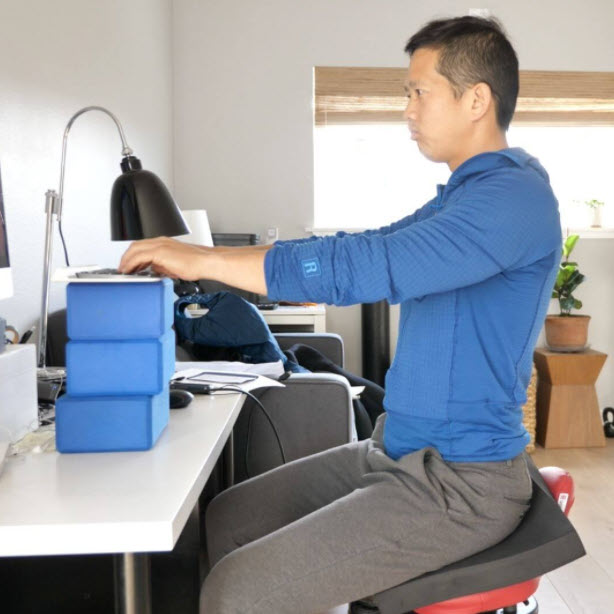
Keeping your hands high while typing forces more muscle activity than is necessary in your chest and anterior shoulders.
Good posture while typing is the art of finding a stable position that allows you to focus on the work instead of constantly using muscles to prevent yourself (or parts of yourself) from falling.
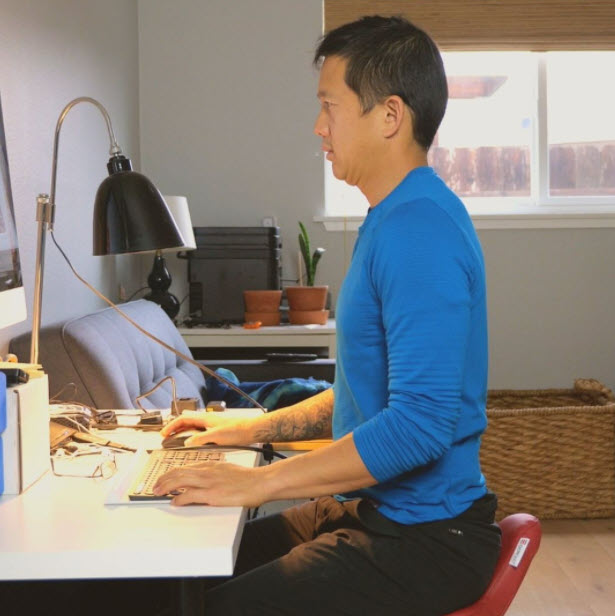
You don’t have to stay in “perfect posture” all day, but it’s something you should be able to achieve.
Once you can achieve good posture while sitting, your work life becomes a lot easier. It’s a sign that you have enough muscle balance for sitting and achieving an efficient sitting posture.
However, it’s important to remember that achieving “good posture while sitting” is not all you need for a happy, healthy body. In fact, there is no one “perfect posture” to sit in for 8-plus hours a day, 5 days a week.
Even if you sat with good posture all day long, you’d still end up with aches and pains. For example, if you put on a full body cast that kept you in perfect sitting posture twenty four hours a day, you would not feel strong or healthy. You would get pain from muscles decaying.
Ultimately, the human body needs movement to feel good. So it’s important to be able to achieve good sitting posture, AND it’s important that you move into and out of many different postures and positions throughout the day to keep your body feeling good.
“Good posture” means the ability to access the most mechanically advantageous body position(s) for any given task.
Watch this video: How to Study with Good Posture
Good Standing Posture
Good posture while standing is about finding an efficient position while at rest.
If you are looking at yourself from the front, you want to see symmetry. You want shoulders and hips level. You want your head centered! You want your feet and knees in symmetrical positions.
From the side, you want to see a straight line going from the front of your ankle up through your knee, hip, shoulder, and ear. Your spine should have low amplitude, and gentle curves that follow that vertical line. That’s good posture while standing.
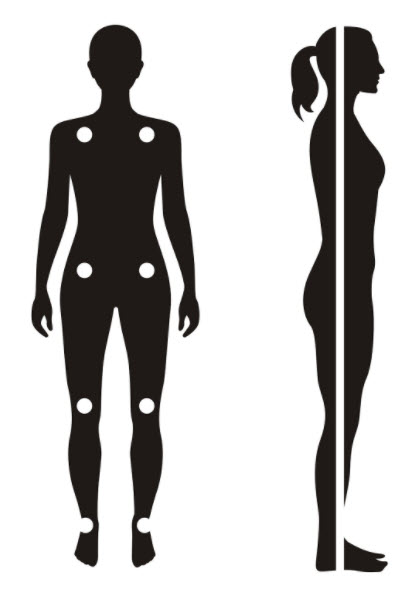
Watch this video for a visual explanation of good posture and bad posture:
If you push your hips way forward as you stand, you’ll find that your muscles need to work to keep you from falling over. If you allow your breast bone to sink closer to your pelvis so you’re in a perpetual hunch, you’ll notice your neck, spine, and shoulder muscles working all day.
These postural deviations mean you’re less efficient; You’re burning energy just standing there!
But remember, even with optimal standing posture, the “best position” is the “next position,” meaning the goal is to achieve a healthy baseline posture for muscle function so that you can ultimately position yourself for unexpected moments and movement. Training for “good posture” means training to gain greater control of your body within a particular position, or within a greater variety of positions, so you can be prepared for anything.
Good Athletic Posture
Good posture isn’t just about sitting and standing. Good posture also has to do with your body position in various activities.
For example, if you’re skiing, there are specific body positions that will make you better or worse at getting down the hill efficiently and safely.
If you’re golfing, there are specific body positions that will make you more or less effective at hitting the ball.
If you’re doing gymnastics, there are specific body positions that will make you better or worse at performing your routine without busting an ankle or flopping on your face.

Good posture for paddling involves a lot of extension in the spine and work from the back muscles. Photo by Nataliya Vaitkevich on Pexels.
If you’re surfing, there are specific body positions that will make you better or worse at catching waves.
There are also specific (and very different!) body positions that will make you better or worse at riding waves. The posture you adopt to paddle is totally different and not optimal for the act of riding the wave!

Good posture riding a wave looks very different than the posture and muscle activity required to paddle out to the wave. Photo by Knut Robinson on Unsplash.
Ultimately, your goal is to have the ability to achieve and maintain efficient posture (body position) that gives you the best chance of success in any chosen activity from moment to moment.
To be clear, good posture in activities is highly activity-dependent. For example, bad posture in golf might be excellent posture for a hockey goalie.
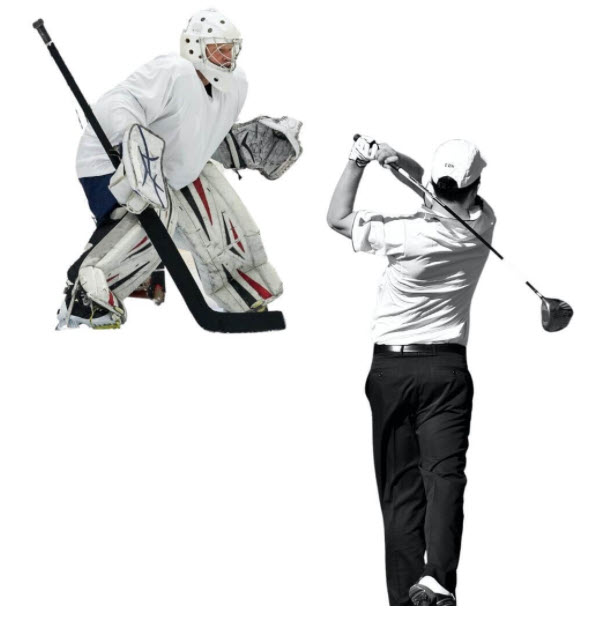
Good posture in one sport would be terrible in a different context. Goalie image by Tony Schnagl on Pexels. Golf image by Patrick Case on Pexels.
Your idea of good posture should expand beyond just good posture while sitting and standing. But those postures are useful to gauge baseline function and to understand some basic principles. How you sit and stand gives you an idea of what your muscles can and cannot do, and hints at what you will be able to do under more dynamic circumstances, like surfing.
What I’m saying is that if you want to feel healthy, strong, and confident, find good posture in a wide range of activities and in every moment within those activities.
Watch this video: How To Release Tight Hips—The Correct Way For Hip Stretches
Bad Standing Posture
Bad posture is inefficient body positioning. It’s when you position your body parts in a way that requires extra muscular activity or that limits your options should a new challenge arise.
Let’s look at common poor posture issues while standing to clarify this.
Let’s say you have a hunched back, rounded shoulders, and a head that juts forward.
This will mean your posterior neck muscles will shorten from holding that position all day (otherwise your head would slump down). Your posterior shoulder muscles go long and slack, often feeling tense and tight as they lose function at other lengths (i.e. they won’t be strong when shortened). The muscles in the front of your shoulders and in your chest will shorten and weaken as they acclimate to a constant hunched posture and lose strength at lengthened positions (i.e. they won’t be strong when stretched longer).
Say you go through your days with this poor posture, then one day you need to stand up straight to reach something. You try to straighten and reach up... and then you feel a sharp twang in your back, neck, or shoulder. With a simple, generally innocuous movement, you’ve come up against your limits! You find you can’t straighten your spine enough to give your shoulders full range of motion and you hurt your shoulder or back! You’re straining muscles that have been locked in an unideal position for far too long, and you’re facing the consequences of poor posture for a few weeks while you recover.
Bad standing posture could be a combination of lots of things on the following list (and this isn’t even a comprehensive list!):
- hyperkyphosis (AKA hunchback posture)
- hyperlordosis (AKA anterior pelvic tilt)
- torso rotation
- unilateral shoulder elevation (one shoulder higher than the other)
- unilateral shoulder depression (one shoulder lower than the other)
- unilateral hip elevation (one hip higher than the other)
- asymmetrical abduction or adduction of a hip joint (legs turned out at different angles).
- etc. etc. etc.
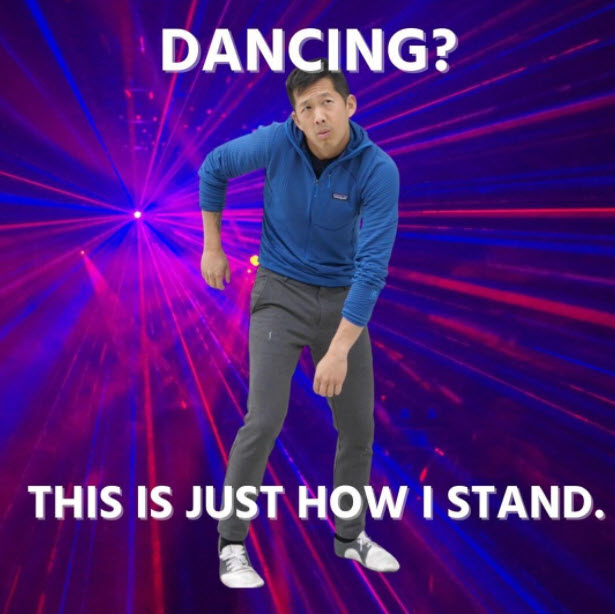
Your standing posture tells you what your muscles can do in a sedentary, stable state. Can your muscles arrange the bones in an efficient way with only the force of gravity acting on it?
If you have one shoulder rounded, the rib cage twisted, one hip higher than the other, and leg and foot tweaked one direction, while the other leg and foot do something totally different, you have a clear picture of your muscle function. Your muscles are wildly imbalanced at rest. They do not exert balanced forces to keep your body symmetrical and relaxed at rest!
Put a disorganized body like that into motion, and it should be no surprise that muscles and joints start moaning, aching, and groaning from the abuse.
Many of us live perfectly well with some of these postural issues, so don’t let yourself get too worked up if you notice that you have four or five (or more) of the items on the list. For the vast majority of people, all of these postural issues can be overcome with time and patience. And even if you don’t fully overcome them, making some progress to correct them can greatly improve your quality of life.
See also: How to Fix Muscle Imbalances and Muscle Dysfunction
Does Bad Posture Really Matter?
You don’t always need to have good posture. It’s not a life and death issue.
But it’s a good idea to be able to achieve good posture when you need it. And to do that, you need to practice good posture!
Sometimes people say, "But you can have bad posture and not have pain. You can have bad posture and play sports. That proves that bad posture doesn't matter."
It's common to think there is no such thing as "good" or "bad" posture. This is understandable because modern daily life does not often confront us with the limitations of our bad posture.
However, consider these two scenarios:
- You need to deadlift 200-300 pounds from the floor. Is there a way to position your body optimally to maximize strength output and minimize injury? If you answer "no," you've clearly never attempted it. You may be able to pick up a five-pound package with poor posture, but once the stakes are higher, the consequences of bad posture are obvious.
- You need to carry a 50-pound bag of rice on your head for a three-mile walk. Would different postures affect your energy output or potential for injury? The answer here is a clear “yes.” How you hold your head and neck relative to your torso will drastically affect what muscles you use and how the jolts and bumps of the journey transmit through your joints.
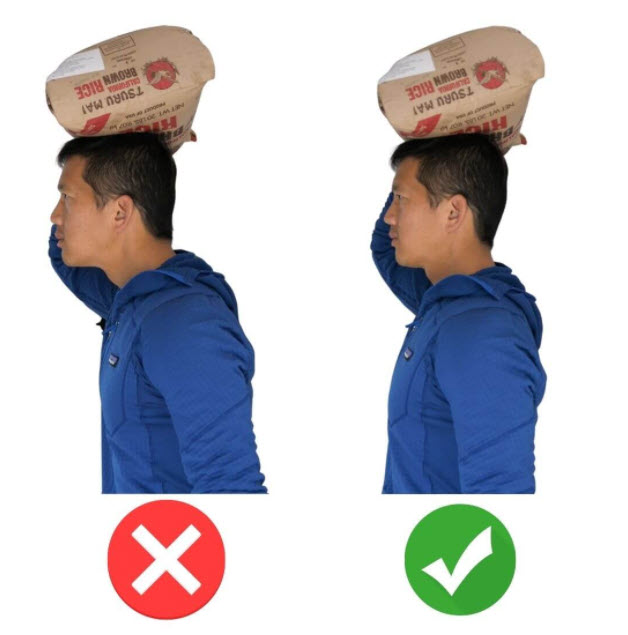
Properly aligning the load atop your head, spine, and hips will make the job easier (your muscles need to work less if the load is balanced on the column that is your bones). With forward head posture, your neck and shoulder muscles will become strained quickly, and you'll be on the side of the road with physical discomfort.
In daily life, poor posture isn't an issue until the speed, weight, or repetition of the activity at hand hit the limit of what your body can tolerate. It's not a problem… until it obviously is.
Just because some people can function with poor posture without pain doesn’t mean there isn’t an effect, and it doesn’t mean that pain won’t be coming down the line.
Similarly, I’ve heard doctors, physical therapists, and trainers say something like “Everyone has some asymmetry, so symmetry in posture doesn't matter.”
It sounds seductively simple, but it also ignores a basic reality: If a structure is imbalanced, work has to be done to keep things from falling over!
Just think of the last time you played the game Jenga. If you have the tower in an imbalanced arrangement, it will topple unless you hold it up with your (desperate) hands.
This video shows you the fallacies of thinking postural symmetry doesn't matter:
Good posture and bad posture for a specific activity can mean the difference between being able to do something at a high level and not being able to do it safely, or at all.
See also: How to Identify Muscle Imbalances and Muscle Dysfunction
What Causes Bad Posture?
Before we talk about how to fix poor posture, I want to be clear about the causes of bad posture.
It’s RPP: Repeated Position Practice.
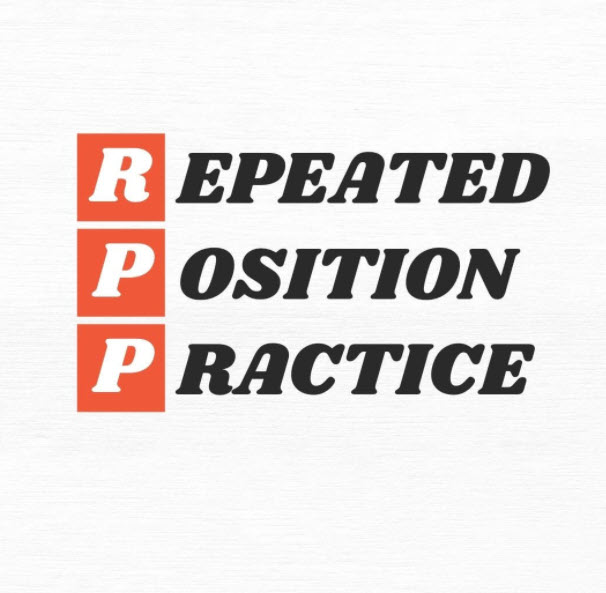
If you practice poor posture, you’ll get great at poor posture!
If you practice good posture, you’ll get better at good posture!
What trips up modern humans is the erroneous belief that posture is purely genetic.
While it’s true that some elements of your posture are determined by genetics (like ratios of bone lengths, your maximum and minimum height range, and rare spinal conditions like scoliosis), how you are able to position your bones is a product of practice.
Every time you get into a specific position, your muscles learn that specific activation pattern. Some muscles learn to shorten and contract, while others learn to lengthen and contract. Some muscles learn to lengthen and relax, and some learn to shorten and relax. Muscles all over your body learn their roles for that specific position.
See also: ATM Theory: Your Joint Pain May Actually be Muscle Pain
Gymnasts and dancers can move their bodies in ways you probably can’t. This is not just because they were born that way. Rather, they spend their formative years practicing, practicing, practicing.
There are no elite boxers who have just stumbled into the ring with no practice and defeated the reigning champion because their genetics were just that good.
Being able to throw a punch, do a cartwheel, and stand up straight all require practice.
Modern Western life, however, places a premium on being able to sit for long periods while focused on books or screens.
Common Activities that Lead to Bad Posture
Take a look at how RPP plays out in your life. Are you sitting and slumped at a computer for eight or more hours a day? Is it surprising that when you stand, you find it difficult to rearrange your body parts? Is it hard to stand up straight and tall or pull your chin back toward your chest?
Are you sitting in a car, on a train, or in a bus right after work possibly looking down at your phone for 30-60 minutes at a time?
It’s all RPP, and it’s why you’re great at bad posture.
To fix bad posture, you need to use RPP to your advantage.
How to Fix Bad Posture with Functional Training
From a bird’s eye view, fixing bad posture is simple.
First, use Repeated Position Practice to train the right muscles to achieve your desired posture.
Second, use functional training exercises to teach the right muscles to fire more efficiently, so you can achieve good posture!
Let’s look at two common kinds of bad posture that people are concerned about.
Kyphosis (Hunchback) Posture
Let’s say you have hunchback posture (AKA hyperhkyphosis or kyphotic posture). Your mid and upper back feel like they’re stuck in a hunched position. When you try to straighten your spine, it feels like a Herculean effort. You can’t maintain good posture for more than 20 or 30 seconds.
This doesn’t mean you’re genetically unable to get into good posture. It means your muscles don’t know how to maintain good posture for more than 20 or 30 seconds.
What caused your hunchback posture? Repeated Position Practice from daily life is all it takes. This video explains the causes of hunchback posture and how to prevent it:
To fix hunchback posture, you need to provide ample opportunities for your body to do the opposite of its typical postural pattern. That means adjusting the positions you’re in all day long. And, it means doing specific exercises and movements that directly teach your body to get out of a hunchback! This is functional training 101.
In the case of a hunchback, exercises that teach your spinal extensors to fire are key. Exercises that retrain the relationship of your head, neck, and spine to align properly are crucial.
Here’s an example of one simple exercise for reversing hyperkyphosis:
For most people, doing just a few simple exercises and making adjustments to daily habits over a few months are all it takes to fix hyperkyphosis. In some recalcitrant cases, it may take a few years. But as long as you continue to use RPP to your advantage, you’ll be on the right track.
Check out my DIY program to fix hunchback posture.
Anterior Pelvic Tilt
Anterior Pelvic Tilt (APT) is when your lower back has a strong arch and the front of your pelvis tips down. It’s sometimes called hyperlordosis (this is just a fancy way of saying the lower spine has an intense curve).
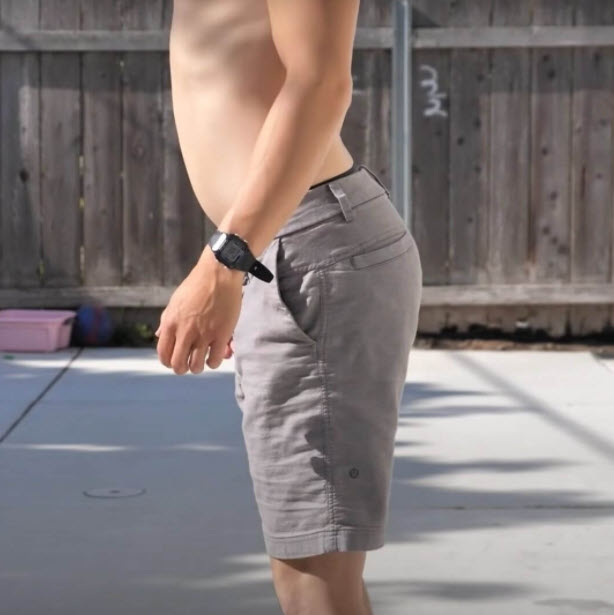
Hyper hyperlordosis.
Imagine your pelvis is a bowl holding water. If you tilt the bowl forward, you’ll spill the water onto your toes. This is what people with anterior pelvic tilt are doing all day long.
If you have an anterior pelvic tilt, the muscles around your abdomen, spine, hips, and legs have been trained to position the body this way. Why?
You guessed it: RPP!
Watch this video: Do I have Anterior Pelvic Tilt?
Many of us absorb the idea that we have to have a big curve in the lower back to have good sitting posture. But sitting in this way teaches the muscles of the lower back and hips to trap the pelvis and spine in anterior pelvic tilt. That training carries over into standing, walking, running, and more.
Underused, untrained, and weak abdominal muscles, hip muscles, and leg muscles make it difficult to fix anterior pelvic tilt posture. For athletic folks who lift weights, an obsession with maintaining lower back lordosis during gym sessions solidifies anterior pelvic tilt with strong, stiff, inflexible muscles.
This video shows you the many causes of anterior pelvic tilt and demonstrates a simple functional training exercise to fix APT:
To fix anterior pelvic tilt, you need to use RPP to your advantage. Identify opportunities to fix anterior tilt throughout the day. Do functional training exercises (like the one shown above) that target the weak muscles in your body so you can get out of an anterior pelvic tilt.
For most people, doing regular exercise and making adjustments to daily habits over a few months is all it takes to fix anterior pelvic tilt. It may take a few years if you’ve got decades of bad habits to unlearn. But as long as you continue to use RPP to your advantage, you’ll be on the right track to fixing your APT.
Check out my free mini-course to fix your anterior pelvic tilt.
4 Keys for Good Posture
We’ve covered a lot. Let’s recap so you have a clear understanding of how to work toward good posture.
- Good posture is when your body is aligned efficiently and ready for (pain-free) action.
- Bad posture is caused by RPP (Repeated Position Practice), not just genetics.
- Bad posture has negative effects, even if they are not immediately noticeable.
- You can improve your posture drastically by using RPP to your advantage and using targeted functional training exercises.
Keep these four keys in mind. Find some habits and positions to change throughout the day. Implement a new exercise regimen. And enjoy your good posture!
Want a program to help you with your hunchback posture? Check out The Hunchback Fix.
Or, if you've got Anterior Pelvic Tilt, check out my free Anterior Pelvic Tilt mini-course.
Have aches and pains? Read How Shifting Your Perspective on Chronic Pain Can Help You Heal.
Want to dive deeper into muscle dysfunction and imbalances? Learn How to Identify Muscle Imbalances and Dysfunction.

